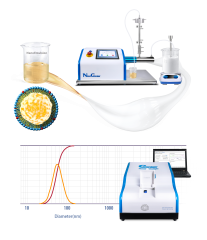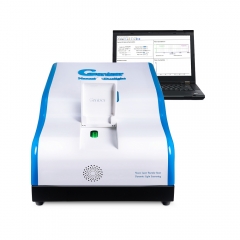Description:
Laser particle sizer with dual wavelength laser especially designed for submicron, nanoemulsion and nano particle size testing.
Application:
Emulsions, liposomes, ceramics, abrasives, inks, paints, nanoemulsions, nanoparticles, clay
Performance:
High detection sensitivity
Blue laser and green laser for more applications
Real-time detection
Fully automatic operation
| Specifications |
| Catalog No. |
Genizer Dual-Light Particle Sizer |
| Description |
Dual-light nano particle sizer (Including a laptop with controlling software) |
| Size Range |
1nm-10μm |
| Dimensions A × B × C |
250mm × 150mm × 460mm |
| Weight |
15kg |
| Accuracy |
<1% |
| Application |
Emulsions, liposomes, ceramics, abrasives, inks, paints, nanoparticles |
| |
| Standard Features |
| Control & Data Collection System |
Connecting to a computer with LPSA software |
| Voltage |
110V/220V 50/60Hz |
| Temperature |
0°C-79.9°C±0.1°C |
| Concentration Range |
0.1 mg/mL-100 mg/mL |
| Scattering Angle |
Vertical |
| Sampling Time |
Fewer than four minutes |
| Detector |
Photomultiplier tube (PMT) |
| Warranty |
1 year against any manufacturing defects |
| |
| Option Features |
| Precision UPS voltage stabilizer |
| Clean |
Ultrasound washer |
| |
| The effect of the color on the size measurement |
|
Sample
Light Source
|
Sample without color |
Sample in Red color |
Sample in Green color |
| Green Laser |
100.662(±0.249)nm |
88.514(±0.342)nm |
100.668(±0.350)nm |
| Blue laser |
100.914(±0.346)nm |
102.250(±0.525)nm |
112.024(±1.504)nm |
| |
For the colored sample, to avoid large deviations in the particle size measurement, users should select a suitable light source. Analyzing the UV-Vis absorption spectrum is a useful aid for the selection of light source. If limited by the spectrum analyzer, the operator can simply switch the laser source between the blue light and green light, based on the concept that the color with a longer wavelength is prone to absorb the light with a shorter wavelength. In general, the blue laser is recommended for samples in red, orange and yellow colors, and the green laser is recommended for samples in green, blue and purple colors.
|
What is the advantage of the Genizer Dual-Light Particle Sizer?
Simple: Sample preparation and analysis software is easy to operate
Dual: Dual wavelength laser for a wider range of samples
Sensitive: High detection sensitivity, accurate precision and rapid measurement
Instant: Real-time detection of dynamic changes in the sample
Intelligent: Fully automatic operation
Refractive Index
1. Temperature correction of refractive index
Generally speaking, for each degree Celsius of temperature increase, the refractive index of liquid organic compounds decreases by 3.5 × 10-4 - 5.5 × 10-4. For some liquids, especially when the temperature of refractive index is close to its boiling point, the temperature coefficient can reach 7 × 10-4. In practice, the refractive index measured at one temperature is often converted into the refractive index at another temperature. In order to facilitate the calculation, 4.5 × 10-4 is generally regarded as the temperature change constant. There might be a slight error in the rough calculation, but it has reference value. In other words, the refractive index decreases with an increase in temperature, and the refractive index changes by about 0.00045 for each degree Celsius temperature change. Correct the reading for refractive index at 20°C using the following formula:
nD(t) = nD(20) - 0.00045(t-20°C)
nD(t) is the refractive index measured experimentally at temperature t. This shows that, when the experimental temperature is higher than 20°C, nD(20) is larger than nD(t), while, when the experimental temperature is lower than 20°C, nD(20) is smaller than nD(t).
For example, nD(t) =1.3667, t=25.2°C, calculate nD(20)
nD(t)=nD(20) - 0.00045(t-20°C)
nD(20)=1.3667+0.00045(25.2°C -20°C)
=1.3667+0.00045 × 5.2
=1.36904
2. Factors affecting refractive index
2.1 Wavelength of Light
The refractive index of materials varies with the wavelength of light. The greater the wavelength, the lesser the refractive index. When measuring, white light is usually applied. When the white light refracts through the prism and sample solution, due to the different wavelength and degree of refraction of each color light, it decomposes into a variety of color light after refraction, which is called “dispersion.” The dispersion of light will make the boundary between the light and shade of the field of vision unclear, resulting in measurement errors. In order to eliminate dispersion, a dispersion compensator is installed at the bottom of the Abbe refractometer observation tube.
2.2 Temperature
The refractive index of a liquid is dependent on the temperature. As the temperature increases, the refractive index decreases, and vice versa. The scale on the refractometer is engraved at the standard temperature of 20°C, so it is better to measure the refractive index at 20°C. Otherwise, the temperature correction factor should be applied. When the temperature is over 20°C, add the correction factors, and, when the temperature is below 20°C, subtract the correction factors.
| Name |
Molecular Formula |
Temperature °C |
Refractive Index nD |
| Propanol |
CH3COCH3 |
20 |
1.3593 |
| Methanol |
CH3OH |
20 |
1.329 |
| Ethanol |
C2H5OH |
20 |
1.3618 |
| Benzene |
C6H6 |
20 |
1.5012 |
| Carbon Disulfide |
CS2 |
20 |
1.6276 |
| Carbon Tetrachloride |
CCl4 |
20 |
1.4607 |
| Chloroform |
CHCl3 |
20 |
1.4467 |
| Ether |
C2H5·O·C2H5 |
20 |
1.3538 |
| Glycerol |
C3H8O3 |
20 |
1.473 |
| Turpentine |
|
20.7 |
1.4721 |
| Olive Oil |
|
0 |
1.4763 |
| Water |
H2O |
20 |
1.333 |
| |
|
|
|
| Name |
Molecular Formula |
Temperature°C |
Refractive Index nD |
| Water |
H2O |
0 |
1.33395 |
| Water |
H2O |
5 |
1.33388 |
| Water |
H2O |
10 |
1.33369 |
| Water |
H2O |
15 |
1.33339 |
| Water |
H2O |
20 |
1.333 |
| Water |
H2O |
21 |
1.3329 |
| Water |
H2O |
22 |
1.3328 |
| Water |
H2O |
23 |
1.33271 |
| Water |
H2O |
24 |
1.33261 |
| Water |
H2O |
25 |
1.3325 |
| Water |
H2O |
26 |
1.3324 |
| Water |
H2O |
27 |
1.33229 |
| Water |
H2O |
28 |
1.33217 |
| Water |
H2O |
29 |
1.33206 |
| Water |
H2O |
30 |
1.33194 |
| Water |
H2O |
35 |
1.33131 |
| Water |
H2O |
40 |
1.33061 |
| Water |
H2O |
45 |
1.32985 |
| Water |
H2O |
50 |
1.32904 |
| Water |
H2O |
55 |
1.32817 |
| Water |
H2O |
60 |
1.32725 |
| |
|
|
|
| Name |
Molecular Formula |
Temperature°C |
Refractive Index nD |
| 0% Ethanol 100%Water |
C2H5OH |
20 |
1.333 |
| 10% Ethanol 90% Water |
C2H5OH |
20 |
1.339 |
| 20%Ethanol 80% Water |
C2H5OH |
20 |
1.3447 |
| 30%Ethanol 70% Water |
C2H5OH |
20 |
1.35 |
| 40%Ethanol 60% Water |
C2H5OH |
20 |
1.3545 |
| 50%Ethanol 50% Water |
C2H5OH |
20 |
1.3583 |
| 60%Ethanol 40% Water |
C2H5OH |
20 |
1.3612 |
| 70%Ethanol 30% Water |
C2H5OH |
20 |
1.3634 |
| 80%Ethanol 20% Water |
C2H5OH |
20 |
1.3648 |
| 90%Ethanol 10% Water |
C2H5OH |
20 |
1.3657 |
Terms:
D10, D50, D90: Refer to the size value of the particles at 10%, 50% and 90% cumulative volume respectively.
V%: The cumulative volume percentage, which corresponds to the curve of the rising trend.
S%: The volume percentage corresponding to a histogram or undulating curve.
Tips:
Operating environment: 5-35°C (temperature), <85% ( relative humidity)
The equipment is recommended to be placed in a clean, dry and constant temperature room.
In the moisture environment, the signal may be dysfunctional because water condensation will affect the laser light path. Please keep in the dry environment for measurement.

 USD
USD

 949-932-0294 Los Angeles
949-932-0294 Los Angeles  Nano@Genizer.com
Nano@Genizer.com